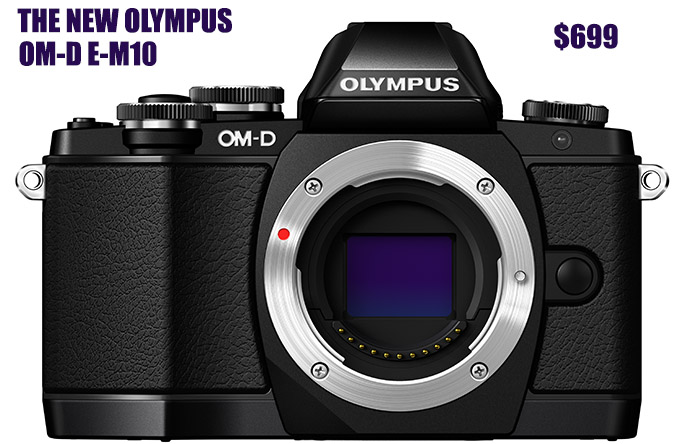
The OM-D E-M10 and 25 1.8 Lens! New Olympus Firecrackers!!
Sweetness! It must be new camera week as just now Olympus officially announced the much talked about and rumored “baby” E-M5, the E-M10 (right after Fuji dropped the HOT X-T1)! This is IMO a $699 firecracker that will allow anyone to get a taste of the fantastic E-M5 at a great price point. The E-M10 is an all metal body full of features and is pretty much the full IQ of the E-M5 and E-M1 in more affordable body that any enthusiast can afford. The OM-D E-M10 will NOT replace the E-M5. Instead the lineup will remain as it is for now – the starter E-M10, the middle of the road E-M5 and the rock n rolling pro, the E-M1. I feel this is a great move as it gives a more affordable option to those wanting the OM-D experience. Same IQ, same solid build, same experience!
If anyone has shown that the Olympus M 4/3 offerings can hang with the big boys it is this very website. Guest post after guest post has shown the power of these little Olympus bodies and IMO they can do anything an APS-C can do besides a little bit less performance at high ISO. They are faster, more accurate in the AF, have better lenses, more lenses and better build than just about any comparable mirrorless body. I am a HUGE HUGE fan of the E-M5 and E-M1 and I expect the E-M10 to be just as wonderful with a few dumbed down features such as 3-Axis IS to the 5-Axis of the more expensive brothers.
To see some wonderful examples of what these Micro 4/3 Olympus bodies can do click HERE, HERE and HERE.
You can pre-order the new OM-D E-M10 body only in BLACK HERE or SILVER HERE at B&H Photo.
You can also buy them in kit form – BLACK or SILVER.
Amazon also has the E-M10 for pre-order HERE!
Below are the quick notes I took at last weeks briefing on the camera:
New 3 Axis IS
8 FPS shooting
Built in WiFi and Flash (first time for flash)
$699 body 0nly
$799 body and kit 14-42 II kit
New Grip – very cool design!
The New 25 1.8 Lens
I am also VERY excited about the new Olympus 25 1.8 lens even though we already have the amazing Panasonic 25 1.4. I will tell you why: The design is small, high quality and uses the same optical formula as the super sweet 45 1.8, which is a stellar lens. It will be available in black or silver and for $399. It will focus FAST, be silent in Autofocus and I have no doubt it will be an amazing lens. I have my pre-order in! At $399 this is the biggest no brainer for any Micro 4/3 user who has not yet jumped to the Panasonic 25 1.4. I can not tell a lie..I prefer Olympus lenses to Panasonic lenses as I love the design, feel, silence and speed, oh, and the IQ. The lens below is on the silver OM-D E-M10. NICE. For $1100 you can get the E_M10 and the new 25 1.8 (50mm equivalent) so you have your camera and fast 50, all in a small but high performing package.
Of course I will be reviewing the new OM-D E-M10 as soon as I can get one!
You can pre-order the new 25 1.8 Lens at B&H Photo in Black HERE or in Silver HERE.
Other new Olympus Cameras and Lenses announced…
Olympus has also announced a new super zoom, the SP-100 (A 50X $399 camera with EVF) as well as a new TOUGH camera, the TG-850 for $279 with swivel LCD and drop proof, freeze proof, water proof and crush proof all the way (I will review this one). There is a new fisheye lens cap lens and a new pancake version of the 14-42 Kit zoom (that will NOT be the included lens with the E-M10..OLD ONE IS BUNDLED). The new zoom is actually smaller than the older 17 2.8 Pancake!
The new 9mm fisheye lens cap!
You can read all about the SP-100 HERE and the TOUGH HERE.
MORE INFO ON THE NEW E-M10!
OLYMPUS EXPANDS OM-D® CAMERA LINE-UP WITH NEW, EXTREMELY COMPACT E-M10 — THE OM-D FOR ALL
The Image Quality and Power of the E-M1 and E-M5 are now Packed into a More Affordable OM-D Body; Two New Lenses Broaden Olympus’s Micro Four Thirds® System
CENTER VALLEY, Pa., January 29, 2014 — Olympus adds to its award-winning OM-D family with the new E-M10, an interchangeable lens camera that combines the outstanding image quality, speed and power of the flagship Olympus® OM-D E-M1 and the Olympus OM-D E-M5 into an extremely compact and stylish all-metal body. Featuring the new TruePic VII image processor, the same found in the OM-D E-M1, 16 megapixel Live MOS sensor, Wi-Fi® technology, a large, high-speed electronic viewfinder, 3-axis image stabilization, ultrafast autofocus and a built-in flash, it’s the OM-D for photographers looking for an affordable, yet powerful, system camera they can use every day. The new, super-slim M.ZUIKO® DIGITAL 14-42mm f 3.5-5.6 EZ pancake zoom lens and the super-bright M.ZUIKO DIGITAL 25mm f1.8 expands Olympus Micro Four Thirds line-up to 15 lenses.
Best-In-Class Image Quality The Olympus OM-D E-M10’s 16-megapixel Live MOS sensor, combined with the TruePic VII image processor and M.ZUIKO lenses, delivers beautiful image quality with high resolution, superior color reproduction and high sensitivity that exceeds other cameras in its class. A maximum sensitivity of ISO 25600 is perfect for shooting dark scenes and indoor shooting locations, and ISO LOW mode (100 equivalent) expands the low-sensitivity end. The sensor’s rich dynamic range makes smooth gradations possible and beautifully depicts high-contrast highlights and shadows. Fine Detail Processing II technology configures the appropriate sharpness processing for each individual lens resulting in natural, high-quality resolution.
The Olympus OM-D E-M10’s in-body 3-axis image stabilization system is derived from the world’s first 5-axis system in the E-M5 and E-M1. The 3-axis version effectively counteracts yaw, roll and pitch with both still shots and HD movies, regardless of the lens attached to the camera yielding great results even in poor lighting conditions or when using an exposure time of 1/15 second or less.
Speed
The on-board FAST AF is Olympus’ fastest-ever AF system and uses 81 target areas that cover the whole image. Small AF Target and Super Spot AF modes make it possible to zoom in and focus accurately on minute sections of the frame. The E-M10 is also capable of capturing high-speed action with 8fps sequential shooting, the fast processor supports continuous capture of up to 20 RAW frames or an unlimited number of JPEG frames*, and the Continuous Auto Focus with Tracking mode accurately tracks and captures moving subject as fast as 3.5 fps.
Beautiful OM-D Design
The ultra-slim, compact and lightweight Olympus OM-D E-M10 body is built with precision-machined metal parts and a premium feel that inspires the user. Two easy-to-reach metal dials give excellent operability and improved control, and the grip is designed to rest comfortably in the user’s hand. Despite its size, the E-M10 is the first OM-D with a built-in flash that is optimized for 1/250 second synchronization, a benefit for daytime flash photography.
High-Speed Creative EVF
The large, 1,440,000-dot electronic high resolution viewfinder (EVF) located on the optical axis of the E-M10 features a 120-fps refresh rate, a 100 percent field of view and maximum 1.15x magnification to help accurately frame shots. An eye sensor seamlessly switches the display between the tilting, 3.0-inch touch-screen monitor and the electronic viewfinder. Camera setting information, such as shutter speed, is displayed at the bottom of the viewfinder and photographers can take full advantage of the EVF’s ability to display the effects of various exposure adjustments, Art Filter effects and Creative Controls like Color Creator, Image Aspect control, Highlight/Shadow control, Live Histogram, Display of five different grid patterns and even a Level Gauge — all without having to remove your eye from the viewfinder.
In-Camera Creativity
New features, including Live Composite Mode and Photo & Movie Capture, expand the user’s creative potential. Live Composite Mode is a tool that offers previews of long exposures in the EVF, a perfect tool for anyone looking to easily capture light trails when shooting a star-filled sky. Photo & Movie Capture lets users shoot high-quality still images without interrupting the video recording. 12 Art Filters, three HDR capture modes and Photo Story support your photographic imagination.
Built-In Wi-Fi
The Olympus OM-D E-M10 includes built-in Wi-Fi, and the setup is simple. By quickly scanning the QR code displayed on the camera’s LCD with a smart device, it syncs with the Wi-Fi network created by the camera. The free Olympus Image Share smartphone app synchronizes a user’s smartphone and E-M10 so the camera’s Live View is effectively displayed on the phone. In this way, the camera can be controlled by touching the smartphone display as if it were the camera itself, and users can send selected images directly to websites and social media.
Two New Micro Four Thirds Lenses
Olympus has also introduced two new Micro Four Thirds lenses to its line-up. The super-slim M.ZUIKO DIGITAL 14-42mm* f3.5-5.6 EZ pancake zoom lens measures just .9 inches thick, making it the world’s slimmest standard zoom lens.** It has a smooth electric zoom that is suitable for shooting movies, and can also be zoomed in and out remotely using compatible smartphones through the updated Olympus Image Share app. The super-bright, lightweight, high-performance M.ZUIKO DIGITAL 25mm* f1.8 lens has a fixed focal length and is ideal for capturing portraits or close-ups from as little as 9.8 inches away. Both new lenses are sold separately.
New Micro Four Thirds Accessories
A host of new Micro Four Thirds accessories join the Olympus Micro Four Thirds line-up, including the fixed-aperture F8.0 Fish Eye Body Cap lens with a focal length of 9mm (35mm equivalent: 18mm). It’s an ultra-slim accessory for creative wide-angle shooting through its 5-element, 4-group lens construction. The multi-use lens barrier MF lever switches from pan focus shooting to close up 8-inch shooting with a single press of the lever. The ECG-1 matching ergonomic grip is a removable grip exclusively for use with the E-M10. Designed for absolute comfort, the grip is the perfect thickness for resting the ring finger and pinky when holding the camera. A single press of the lever on the bottom of the grip easily removes it, making replacing batteries and memory cards seamless. The MCON-PO2 macro converter is compatible with six Olympus Micro Four Thirds lenses and adapts them for close-up shooting. Finally, the Automatic Opening Lens Cap LC-37C is available exclusively for use with the new M.ZUIKO DIGITAL ED 14-42mm F3.5-5.6 EZ. When the camera is turned off, this accessory protects the lens from dust and scratches, and when the camera is powered on the lens cap instantly opens for snapshots and quick shooting.
*35mm Equivalent
**As of January 29, 2014. Shortest distance between the mount and the front end of the lens, when retracted.

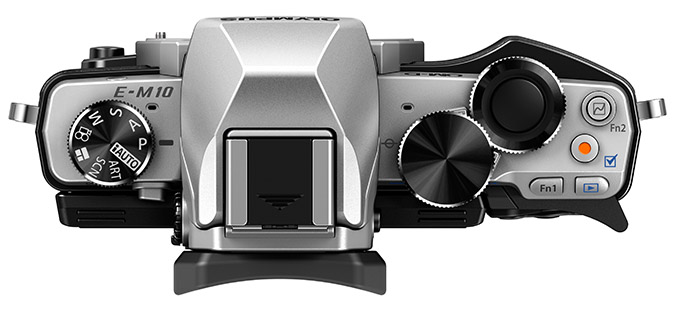
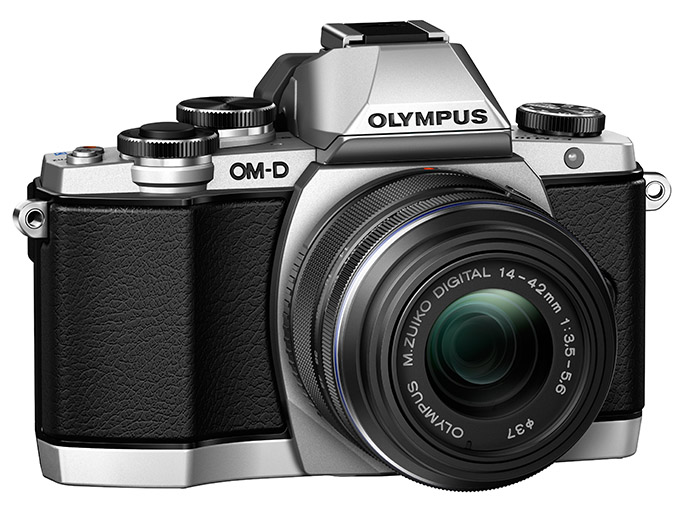
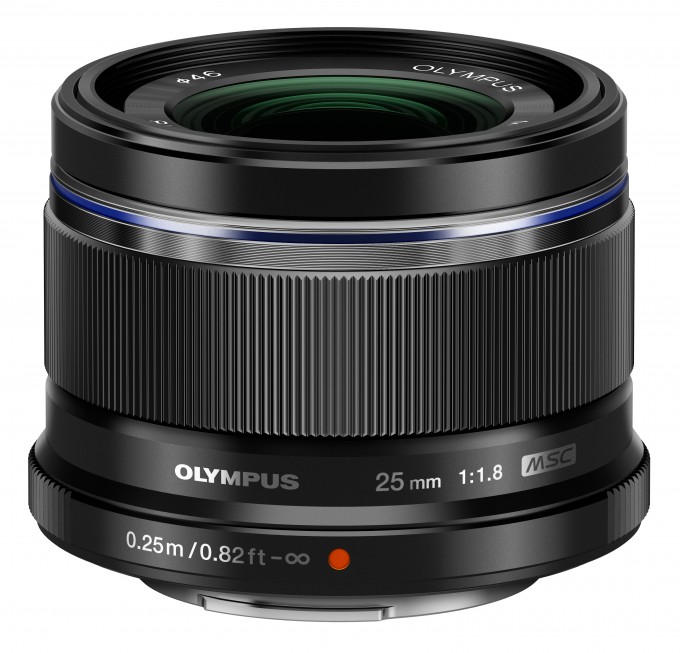
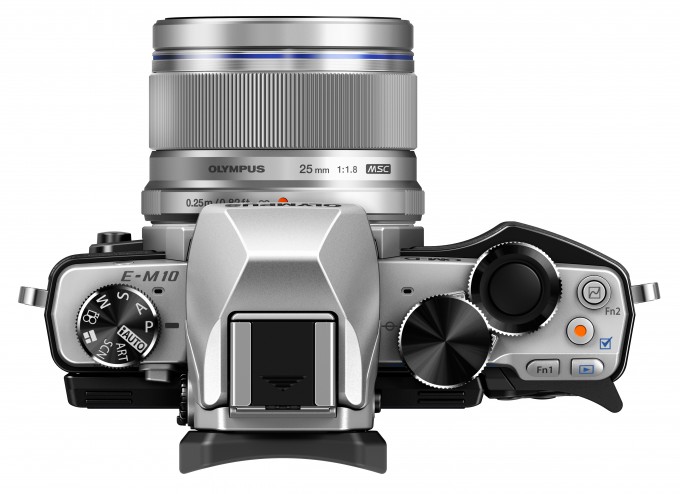
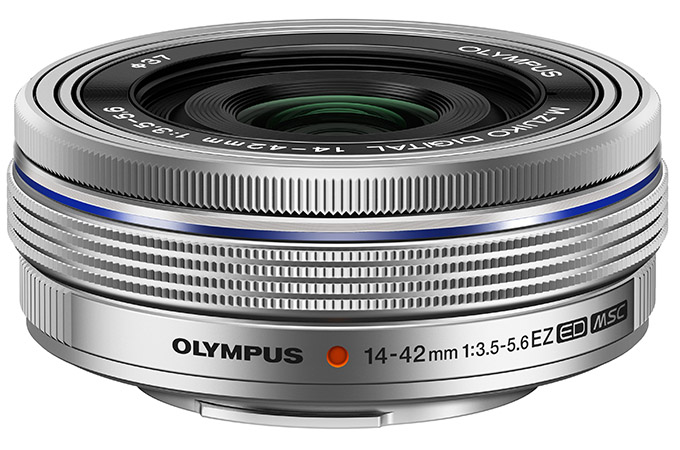
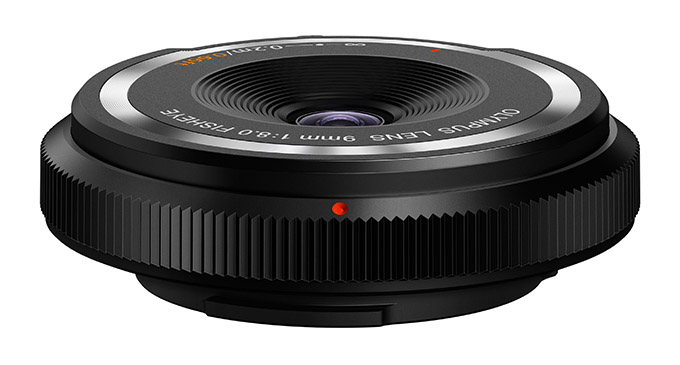
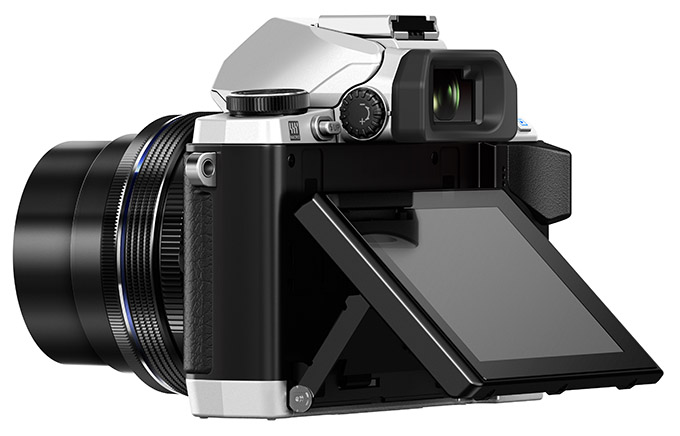


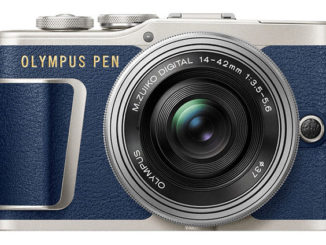
Hello, I got my OM-D E-10 camera about 3 weeks ago. I love it, however, I lost the lens-cap that came with the “M ZUIKO Digital 14-43 mm 1:3,5-5.6 phi 37” lens. I ordered 2 types from Amazon but they both were unable to cover the lens. Where can I get one to buy? Thanks
Sorry I m not that much fluent in english. I managed to test the EM10 in my job, mainly with the Olympus 45mm 1.8. In fact I used it to shoot moving customers indoors with no natural light. I turned the continuous shooting Low, AF-C on, iso 3200 and F1.8. Well I can tell this EM 10 is a little wonder, super fast and nearly never miss AF.
The only thing that disappoint me was when I used panasonic lenses on the same conditions (continuous shooting, AF-C, moving people). Well the AF nearly always failed and the fps dropped at best to 1.5 fps (af-c because af-s works perfectly but it s slow). So I tried the 2 panasonic lenses (20mm 1.7 and 14mm 2.5) on the EM 5 and guess what ? The same results : so slow and AF failed… Today the Olympus sales representative came for his monthly visit and I told him about the panasonic issues on olympus bodies. He had no idea about it and found that weird after trying it. Then he gave me a hotline number in Hungaria I ll try to phone tomorrow to clear that point. Anyway maybe some of you had the same problem of continuous shooting using Panasonic lenses on Olympus bodies… In fact I planned to get a EM10 with the panasonic 25 1.4 but after all maybe I ll get the Olympus 25 1.8 (even in real life I dont use continuous shooting often, but just in case).
Did the Olympus EM10 improve skin tones way way better than Fuji. Jesus, they are perfect I need to see some more to confirm. Here is a link http://www.ephotozine.com/article/olympus-om-d-e-m10-expert-review-23910
Steve, being an ardent admirer of Olympus yourself, quite justifiably so as they are great, your glowing tribute to Panasonic Gx7 touched my heart, as I had more or less decided to own one. Until I read your favourable comments about Oly OMD10!! Please get me out of misery and review OMD10 against GX7 and help me decide.. Remember some of us take your word as the ultimate truth in reviews. Thanks
What a lot of hot air you guys talk. You only need to use an EVF for framing and composition, and who needs sharp. (Search for “Dianne Owen FRPS” UK) This is a great camera for the price point, Small, light (probably) well made. Plus the added bonus of being able to control it from a ‘phone. It will do the job for me.
I would love, love, love to see a good comparative review of the new Olympus 25mm and the Panasonic 25mm. I have the Panasonic 20mm, which I’m very happy with, but for my main lens I’d like to get a slightly flatter look to my photos, hence wanting to buy a 25mm.
My initial impression, based on sample shots I’ve seen so far, is that the Olympus is very sharp, but for my tastes too sharp looking. The Panasonic seems less in-your-face sharp, yet very much sharp enough. Both are probably great lenses, but rendering and flare resistance would probably be the deciding factor for me.
I’ll wait for your review of 25 1.8. I was saving money for panasonic leica 25 1.4, but the price point, smaller size, and being olympus lens (I have olympus ep3), makes this lens very attractive.
Hello Steve, I have been following your posts on the Olympus kit for a couple of years now. I used to shoot Canon gear, 60D, battery grip, 24-70, 70-200, 10-22, 50, sigma 17-50, Sigma 18-250…sold them to switch to Olympus EM1, EM5, 12-40, 17, 45, 60, 14-150, 55-200 and now the release of the 25 on pre order with my local camera store). I have been eagerly awaiting the 25 as I like to do street photography (still learning though). My arthritic elbows are thanking me for the switch. As much as I am a fan of canon gear, it was way too heavy and painful to use. I don’t see any reduction in “image quality”; in fact I think the oly is better than my 60D, especially in low light/high iso. Apart from the financial hit I took and that I still like canon kit, I don’t have any regrets switching. I chose oly over other manufacturers for a whole bunch of reasons which you have already mentioned. My experiences in using the oly kit are pretty much in accordance with yours. I agree wholeheartedly with you that the OMDs are the type cameras that make photography fun and get you out shooting.
Thank you for your very comprehensive reviews; they have been very informative and fair and I regularly refer people to this site when they are looking for reviews about mirrorless cameras. The improvements and advances in m4/3 technologies in the past 2 years have been spectacular.
Thanks so much! Enjoy Micro 4/3! I am also waiting for the new lens..I expect it to be fantastic.
The EM-10 indeed looks great. The Olympus boys are on a good track. I never quite could move myself to buy the ‘standard’ body cap lens, but I’m looking forward to Steve’s test of the new fisheye body cap lens. I have a Zenitar 16mm for my analog Nikon camera(s) and if the Oly is not too expensive I’d fancy one.
Steve, again a big thank you for your fabulous website and for all the great news about mirror less gear. The monthly photo rag that I buy (the french ‘Réponses Photo’)seems to dislike everything that is not hollow and plastic… What we need now is a good mirror less photo rag to browse on sunday morning on the couch with y’er feet up.
Two things:
I’ve had the 17/1.8 for months and it doesn’t have the “bite”, of a number of other Olympus & Panasonic primes that I have. I will be happy if the 25/1.8 has the same look as the 45/1.8.
I have an E-M1 and E-M5. If one shoots JPGs, the E-M10, which has the same image processing hardware and software as the E-M1, is probably the better camera to get than the E-M5. Even with a none Olympus lens like the 14/2.5, The E-M1 removes all sorts of CA and purple fringing in the corners and edges. Certainly makes the 17/1.8 look better. The AWB, default color rendition and contrast is more neutral and accurate with the new processor.
This is probably the Olympus camera that I am looking for. I like the shorter hump over the E-M5 and E-M1.
How can you say the 25mm will be amazing, before release or review? The 17mm was greatly anticipated and let most down considering its price (I know you like it but you’re in the minority here). The 45mm was great, yes. But still, don’t you think you’re jumping the gun?
Well, I love the 17. I think people who have actually used it (as opposed to just run tests) like this lens.
Lots of people who have used it feel it’s overpriced and doesn’t perform up to spec.
Like who?
I’ve got the 17. It’s great, especially in low light.
What does – doesn’t perform up to spec- mean?
What is the spec it doesn’t perform to? Bit puzzled on that one.
I’m getting fantastic results so maybe it’s the owners that are not- performing up to spec?
Will you be doing a comparison between the EM-1 and the new Fuji 1-XT?
Yes Sir!
@Mikhail
There’s more to an EVF that pure number of pixels. The NEX-6 has a nice EVF, but it’s not leaps and bounds better than the E-M5.
Also just because the E-M5 has been out for a while, it’s not obselete.
Aside from the build quality, I don’t know what this camera has over the EP5 (NOT EM5). Granted it is $100 cheaper.
A viewfinder.
Actually, the EP5 has several features the em10 doesn’t have, like a better viewfinder (though it’s add-on), 1/8000 shutter speed, faster flash sync speeds, 5-axis IS, and a very useful two-way lever changing control dials
Steve, Really am torn between more lenses for E-M1 or moving to Fuji, who also have terrific lenses, and now offer the X-T1. Can’t wait for your review to help with that decisioning process. Is it worth the switch?
Just checked B&H & Olympus sites on the 25mm f1.8.. Yes! Finally! OLYMPUS IS INCLUDING A LENS HOOD WITH THE LENS!! LH-49B, no images of it yet, but, hey! at least you don’t have to pay an extra $45 or so for something that should be included with a lens.
Hopefully, moving forward, all Olympus lenses will included a lens hood.. maybe even start producing old/current ones with them, also.. maybe too much wishful thinking… if they could at least also include a lens pouch, that would be awesome of Olympus to not be so stinger or uh… frugal about including some decent accessories with their lenses. Panasonic does it, they should too.
My favorite new features of the E-M10:
1) Bult-in flash. Sometimes you just need it and I loathe the clip-on.
2) Fn buttons are now programmable to assign ISO and WB to the dials (just like the E-M1’s lever).
I might “downgrade” from the E-M1 because this one is smaller, lighter, cheaper and has everything I actually use. (I’ll wait for the 3 vs. 5 way IBIS comparison). I’d even have some money left over for one of the new lenses.
And I just got the EM-5 based on your answer to my question. Which by the way I love. I know there are better but as a retiree living in an RV, I have to watch my budget. The 25mm looks interesting. Started with the 45 for a prime and the 60 macro. The 25 1.4 was on my list as the next lens. Might change that and then I can started saving for the 12.
The E-M10 is actually a great entry level OM-D camera. Should have same great IQ as previous OM-D’s, and some early reports have noticed negligible differences in IS even though the E-M10 only has 3-axis vs the 5-axis in previous models… strangely, I have also hear the E-M10 actually does have 5-axis IBIS, but only in video recording mode.. not sure why it would only be in video recording mode?
I also have little doubt the new 25mm f1.8 will be a great 50mm equivalent lens at a great sub $400 price.. much like the 45mm f1.8 (which is even better now that I think it’s actually down to about $300 these days).
I’ve stated in other comments before, BUT the only thing I really wished they would have done with this new Oly 25mm is have the built in MF clutch ring.. that was such an awesome feature on the 12mm, 17mm and even on the pro 12-40mm. I really think they should have implemented that MF clutch, especially on this 25mm focal length! Oh, well… Lastly, I haven’t read any info on the build of the 25mm, but if it’s like the 45mm, which it appears heavily designed like, then it’ll be made of plastic, unfortunately… again, really wished they would have made it all metal like the 12mm, 17mm, 12-40mm & 75mm lenses… I can’t confirm if the build is actually plastic yet, but most likely… I guess we’ll see really soon as more reviews and impressions begin to surface on the web & youtube. Regardless, this new 25mm does look interesting and will probably be a great value lens for MFT.
I love the MF clutch as well but Im sure it keeps the price point down without it. Just like the 45 which is the market they want for the 2 lenses. You do see it in the Pro line however. I tend to use the AF+MF setting the most anyway as it suits me best so having the value option is very nice.
Looks like Olympus is trying to corner the mirror-less market. What other camera at this price point is worth buying at this point? The E-P5 is $100 more with no EVF but has 5-axis IBIS and an older processor. Leaves so many questions 😉 I wonder if they will continue with the PEN line at this point as it still offers a more compact body. I wonder how much used E-m5 sales will eat up any potential buyers for this camera as well. You can get a pretty smoking deal on a used E-M5 for around $500-600 right now. Maybe even less after this announcement.
Don’t know if this is useful to readers, but in my quest for a small, pocketable, high quality camera, I own, or have owned Leica X1 (great camera, no longer have), RX100 #1 (mp count too large in my estimation, for such a small sensor, but still have; RX1 (have and will keep). I greatly desire IS, and am extremely disappointed that Olympus is the only company that thinks this is important. Right now, the king of small cameras, and most interesting, in my humble opinion, is the Panasonic GM1. It has interchangable lens, but wouldn’t want to put much of a larger lens on it. I’d just use the one it came with. I’ll probably purchase it. RX1 fits beautifully in a smaller fanny pack. I suppose some of the other cameras, not otherwise noted, would also fit same (minus lens), but I haven’t tested that.
CAMERA SENSOR W H D OZ FITS WHAT?
Panasonic GM1 4/3 3.9 2.2 1.2 7 pocket
SONY RX100 II 1″ 4.0 2.3 1.5 10 pocket
SONY RX1 FF 4.5 2.6 2.8 16 fits sm fanny pack
Olympus OMD M10 4/3 4.7 3.2 1.8 (body) 14 body fits larger belt bag?
Leica X2 APS-C 4.9 2.7 2.0 11 whole thing fits medium belt bag
Fujifilm T-1 APS-C 5.1 3.5 1.8 (body) 16 body fits larger belt bag?
Olympus OMD M1 4/3 5.1 3.7 2.5 17 body fits larger belt bag?
Just to let you know that your review states that the EM10 kit is bundled with the old 11R kit lens while the links to B&Hphoto states at least twice that the EM10 kit is bundled with the 14-42 EZ (new lens)
Olympus told me in a briefing that the E-M10 does NOT..and they made it clear that it does NOT come with the new EZ lens. I think B&H made a mistake. Olympus said they may one day add the EZ lens to the kit but not anytime soon. If they did it would raise the price of the kit. So from Olympus themselves directly to me vocally, the E-M10 is bundled with the OLD 14-42 II lens.
Hi.
Seems there would be different bundles in europe and u.s. (lucky european 🙂 )
http://www.olympus.de/site/de/c/cameras/om_d_system_cameras/om_d/e_m10/e_m10_kits_boxcontents.html
Any chance we’ll ever see a review of the Olympus M. Zuiko Digital ED 12-40mm f/2.8 PRO Lens? It’s been out for quite some time now…
It’s gonna be hard to choose between this one and the EM5 …
I thought about that too for quite a while..em5,gx7,or go with the new kid,em10…..decided to go with the em10…..just enough features to be interesting and priced low enough to not complain about plus I have several lenses anyway and I have several of its battery sizes allready…..should be here Tues from olympus store…
very, very pretty camera
i think this little camera will be brill for street with the new 14-42 pancake for street.
haha…..did i say street….blame the red wine
Looks like a great camera from Olympus at a great price.
Hello to everybody! It would be interseting to see comparison between olympus 25 1.8 and panasonic 20 1.7.
Or between olympus 25 1.8 and panasonic 1.4. If the IQ is the same I might sell my panasonic which I love and but it is just feels a bit to big for my E-M5, and trade the 1.4f for a smaller package 🙂
A comparison of the olympus 25/1.8 and panasonic 25/1.4 would interest me too.
agreed. a comparison between the new oly 25/1.8 and the pana 25/1.4, which i like very much but sometimes it just drops out–great glass but less than stellar electronic performance (sometimes).
Steve I found your comment that Olympus makes the best lenses surprising. I know you are a big fan of Olympus but that is a pretty bold statement… Olympus–most compact lenses in the market–no doubt. Far and away the largest collection of mirrorless lenses–yes. Capable of delivering stunning output in the right hands–of course. Best lenses (optics?)–um that’s very debateable…
Admittedly my experience on m4/3 has been limited to just the 25mm 1.4, 45mm 1.8, and 75mm 1.8 (I prefer primes). The 45mm is an awesome lens and was the one lens that made it really hard for me to part ways with m4/3; I still may come back one day just because of that lens…I simply couldn’t believe a lens so small could produce images so nice. The 75mm was good too but too awkward to use at the same time. I wasn’t impressed though by the 25mm.
There are lots of great lenses being brought to market recently from companies other than Olympus… On the DSLR front (which are harder to design for), Sigma just turned the industry upside down with its 16-35mm constant 1.8 and Canon/Nikon newest kit lenses are no longer the slouches they used to be. In the mirrorless world, I believe you’ve tested Sony’s FE 55mm 1.8 (a lens I currently own so can attest to)–that is a stunning lens that no Olympus lens can match up to optically IMO. Fuji also makes some optically impressive lenses that I found were sharper than their Olympus counterparts.
All the major companies including Olympus have some impressive lenses in their lineup (along with the occasional dud), but I do believe superlatives like “legendary” and “best” that I’ve seen Olympus fans use to describe their lenses are a bit exaggerated. Let’s keep it real!
1st of all, when I reference “best lenses” I am talking about for mirror less which is 98% of what I write about here on these pages. For me the Olympus primes (and there are MANY of them) beat those from Panasonic, Sony, Fuji, etc. All but Leica. The 75 is amazing and in no way awkward to use unless you are using it on one of the mini bodies. The 45 is not quite as good as the 75 but close and the Panasonic 25 1.4 can be stellar but I have seen copies that were off a bit (some would back focus). The Olympus lenses are stellar – the 12, 17, 45, 75, etc. All fantastic and my faves in the mirror less world due to build, size, speed and image quality.
Fair enough. I do love the combination of size and speed from Oly but I do think there are better options out there for sheer optics and sharpness. I say the 75 was awkward in that I had to step back a fair amount to properly frame the shot due to the focal length. Outside this generally wasn’t a problem but indoors it wasn’t feasible at times. Would have been nice had it (and the 45mm) been just a bit brighter @ 1.4 but probably would have made the lens much bigger.
Hmm.. I’ve owned all the Olympus and Fuji primes and must say mano-a-mano that the Fuji primes have the Olympus primes beat. I’m only going to talk about the premium ones and leave out the 17/2.8 pancake and body cap lens. The 75 is the one exception — no (and I suspect never will have a) counterpart from Fuji, laser sharp.
The 45 is superb, especially at that price point but its bokeh doesn’t feel as organic as with the 75. Anyone who’s tried Fuji’s 60 knows how crazy sharp it is. While it only opens up to 2.4, the resulting shallow DoF ends up the same but with a more pleasant bokeh quality. Of course, AF suffers from Fuji using a more classic approach to their lens design for the first 3 lenses. Early reviews tout the soon-to-be released 56/1.2 to be their sharpest yet but of course, I’ll reserve judgment for when I try one out myself.
The 12 is another winner from Olympus but falls short of Fuji’s 14/2.8 (excellent optical distortion correction), which is arguably their best lens to date.
The 17/1.8 I felt got bad raps for being compared to the 75, 45, and 12mm lenses. It’s still very very good but cannot hold a candle to Fuji’s 23/1.4.
If Olympus’ 25/1.8 achieves the same IQ as their 45, this will sell like hotcakes. I just hope the bokeh quality won’t feel as digital. Panasonic’s 25/1.4’s additional shallow DoF capability produces a very pleasant bokeh at the expense of edge fall-off. (Though for me this doesn’t matter since I use it for environmental portraits where I would want edge blurring anyways). Fuji’s 35/1.4 is every bit as wonderful as the Panny 25/1.4 except for the AF issue (fast enough but will never be as lightning fast as micro four thirds).
The 60/2.8 macro in my book is another excellent performer and very well-priced especially for a high IQ macro lens with weather-sealing. Fuji has already released a macro lens so am not holding my breath for a
Fuji lenses can’t hold a candle to Olympus lenses. Fuji lenses are slow, big, expensive and nothing special optically. The image quality of the Fuji lenses somehow doesn’t appeal to me at all. Maybe it’s the sensor and the cooked Fuji RAW files, but I think the lenses determine the typical soft flat dull Fuji look too. Files from an OM-D have that nice 3D pop, like a Leica.
Generalizations (Fuji lenses can’t hold a candle to Olympus lenses) without providing specific examples (which lenses have you tried specifically?) are very fanboy remarks. Fuji cameras are being targeted for the lack of RAW support (Adobe is equally to fault for being lazy, there are plenty of third party software out there) and slow AF (improved in the X-E2, perfected in the X-T1 with predictive AF) but all the lenses (save for the 18/2 which is still very good) are regarded highly by every single reviewer online.
Expensive, you say? Yes but worth it. And that’s because every single XF lens is mostly metal and of the highest optical quality. They have yet to pass the 1000usd mark despite having to cover a larger sensor — CaNikon’s 35/1.4 and 23/1.4 easily clock in for twice to thrice as much. There are comparisons online saying that the newly released PL 42.5/1.2 for micro four thirds has the Fuji 56/1.2 beat by a narrow margin. Maybe so, but it’s doubtful that it’s worth 600usd more.
Bigger? Yes, but what do you expect from having a larger sensor? A fair comparison would be APS-C equivalents and the Fuji XF lenses are still much lighter and smaller in spite being mostly metal.
Do you shoot RAW or JPEG? Your comment is very confusing. 3D pop is related to shallowness of DoF, i.e. faster lenses, larger sensors, whereas the OM-D’s smaller sensor puts it at a disadvantage. What you probably mean is just pop from excellent micro contrast to which I agree is an excellent quality from the Olympus JPG engine. But that advantage is really only significant when you shoot in JPG using an Olympus camera. Fuji’s sensor has its own benefit — higher amount of detail, less noise owing to high ISO performance. As for the Fuji JPEG engine, the Fuji JPG files are very malleable and most don’t find the need to shoot RAW anymore.
I have provided numerous examples on this website time and time again 🙂 I do not do “generalizations” – Everything I say is from experience. I have no axe to grind and I can own any camera system I want to own. It would be in my best interest to HYPE Fuji so I could sell a ton of them through my links. But I speak the truth about MY experiences and feelings after using EVERYTHING out there. I have never been impressed with the build of feel of any Fuji lens. They feel light, hollow and the earlier lenses all were noisy and slow in use. The newest lenses are an improvement, by far. Still, they are far from being anything special in the build. Maybe next to the cheap 50 1.8’s from Nikon and Canon but not next to Leica, Olympus, etc. I always shoot RAW, always. Micro contrast, yes, Olympus beats the Fuji there easily which is one reason why the Fuji files are usually rendered in a flatter way. They have very little micro contrast in comparison to Olympus, Leica, Sigma DP, etc.
The reason Fuji lenses are under $1000 is because they feel like they are under $1000. Go try out an Olympus 75 1.8 or a Panasonic Nocticron or even the 12-40 Zoom (which feels much higher quality than the Fuji 18-55). A metal barrel does not mean it is amazing build. It is what is on the inside that counts just as much as the outside.
First and foremost, that comment was addressed to Ramses and not you, Steve.
I own the 75/1.8 and I’ve been consistent in saying that it is the one best lens for micro four thirds. I have held a 12-40 zoom in my hands. Yes, it feels more high build than the Fuji XF 18-55 which is a KIT lens (i.e. not a fair comparison against a PRO lens) — wait till the XF 16-55 comes out then feel free to compare. Then again, you fail to mention the 12-40/2.8’s quality control issue with metal lens mounts detaching. Very sad for a lens that’s supposed to be a PRO lens. Have you held a 14/2.8, 23/1.4 or 56/1.2 in your hands? Those feel equally high build as the 75/1.8 to me. Then you have the overpriced Panasonic zoom lenses which honestly, feel less well built than my Fuji XF zooms (yes, I’ve owned both). I left way before the PL 42.5 was announced so it wouldn’t be fair for me to comment on it. I’m sure it is a great lens but I question whether it’s worth it’s MSRP. Panasonic tends to mark up their lenses’ MSRP at release while I admire Olympus for being more reasonable with their lens prices.
As for lens IQ, let’s just agree to disagree. I can easily make up for a bit less micro contrast in post.
As for your comment — “It would be in my best interest to HYPE Fuji so I could sell a ton of them through my links.” Come on now, it won’t be in any bloggers best interest to promote every single camera system now would it?! There’s no shame in that; everyone has their favorite cameras systems that they endorse.
cool! does it has an AA filter?
Steve, have you ever reviewed the OMD cameras with adapters to use other mfg lenses?
I just noticed Fuji makes a Leica M mount adapter for the XT1, and Novoflex (and others) makes a Leica M mount for the OMD.
I am one of the few that was not impressed buy the A7 EVF, but the Xt1 and OMD M1 is meant to be better, so I’m now curious about using Leica lenses on these. I’m aware of the focal length increase (about 2X for the Olympus, and 1.5X for the Fuji)
I have no doubt you going to review the 25mm, but pls pls pls review the 9mm fisheye ..
I’ll second that request!
So, does it have the sensor from the e-m5 or the e-m1 (without aa filter)?
As far as I understand it has the sensor from the E-M5 and the image processor from the E-M1
no AA and no PhaseDetect
nice hidden built in flash
The viewfinder of E-M10 is a shame for 2014. While everybody is including ~2.5 million dots this one us 1.5 million. I compared E-M5 viewfinder and E-M1 – they are different like night and day. I’m very disappointed – this is the camera I was waiting for and it doesn’t include a modern viewfinder.
Any thoughts why?
The ONLY good EVF’s today are in the E-M1, Sony A7 and A7r and the upcoming Fuji. ALL of these are well over $1000 cameras – why would Olympus put their premium EVF from the E-M1 in their starter $699 camera? They wouldn’t, doesn’t make sense to do so. When the E-M5 is replaced it will get the E-M1 EVF but again, it is in the price range to get that upgrade. The E-M10 is not. The best EVF on the market today is in the E-M1.
This makes sense. However, looking to NEX-6 which includes premium viewfinder in the same price range, Olympus could have done it as well.
So, the product line looks like this:
E-M1 – large size. premium features
E-M5 – small size, basic features (obsolete)
E-M10 – small size, basic features
Leaving room for:
E-M5 mark 2 – small size, premium features
I’m with you. I like companies such as Fuji who will keep the DNA moving forward no matter what the model is, a good evolution for a company. I suppose it’s a good marketing ploy by Olympus, get someone with your product who’s invested a little in the lenses, they get frustrated with the EVF and move up.
Fuji has most certainly added lower end, de-contented X models to meet price points, just like everyone else has.
This is not necessarily bad, it’s just part of product marketing. Fuji is the same as anyone else in this department.
May I add:
with EVF “rangfinder style”, i.e. without the hump!
Why? To sell, duh…
That would increase the cost, and this is supposed to be the cheapest OM-D.
I’ve never put an eye into the mesmerizing Vf-4, but i have E-m5(and tried Stylus 1, either)and i don’t find any reason to call the Vf-2 “obsolete”.
Sure, there’s better technology on the market, but i’ve never had a single issue with the super-usable Vf-2, IMHO still far better than OVF from cheap Dslr.
This is an entry-level camera, Vf-2 simply does his job.
I have to disagree. I had the E-M5 for over a year, and its EVF was so good it made me swear off OVFs completely. Now I have the E-M1 and it is an improvement, but it is not “night and day” at all. I had both cameras with me for a few weeks, and could compare their EVFs. The difference is not dramatic.
El Caballero, thanks. That’s what I wanted to hear. I have the EM-5 and I am very happy with it. I was lusting for the EM-1 just because of the ‘better’ EVF. If the difference is not dramatic, then I am in peace… 🙂
That was my impression too. I expected the Vf4 to make me go WOW! but when i compared it with my EM5 finder I just went HUH? In fact there was no compelling reason to upgrade to the EM1 for me. Quite happy about that .I’ll Keep using the EM5 and buy some new lenses.
Agree with both El Caballero and Steve J. The EVF of the EM1 is better but in no way is it a game changer. Additionally, the speed of AF was not a significant improvement either ( faster, but still slow for action shots comparatively to a good DSLR) ). Lastly, on my copy of the EM1, for some odd reason – IQ was worse. I ended keeping my EM5 and see if its replacement will have enough improvements and/or “new” features that warrant an upgrade. However, I do love Olympus 4/3 lineup up overall ( especially their lens, in particular the amazing 75 1.8 ) and have ditched my DSLR.